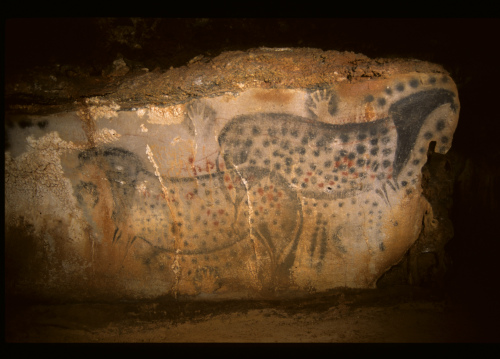LOS ANGELES (AP) _ Cave painters during the Ice Age were more like da Vinci than Dali, sketching realistic depictions of horses they saw rather than dreaming them up, a study of ancient DNA finds.

It's not just a matter of aesthetics: Paintings based on real life can give first-hand glimpses into the environment of tens of thousands of years ago. But scientists have wondered how much imagination went into animal drawings etched in caves around Europe.
The latest analysis published online Monday in the Proceedings of the National Academy of Sciences focused on horses since they appeared most frequently on rock walls. The famed Lascaux Cave in the Dordogne region of southwest France and the Chauvet Cave in southeast France feature numerous scenes of brown and black horses. Other caves like the Pech Merle in southern France are adorned with paintings of white horses with black spots.
Past studies of ancient DNA have only turned up evidence of brown and black horses during that time. That led scientists to question whether the spotted horses were real or fantasy.
To get at the genetics of equine coat color, an international team led by the Leibniz Institute for Zoo and Wildlife Research in Germany analyzed DNA from fossilized bones and teeth from 31 prehistoric horses. The samples were recovered from more than a dozen archaeological sites in Siberia, Eastern Europe, Western Europe and the Iberian peninsula.
It turned out six of the horses had a genetic mutation that gives rise to a spotted coat, suggesting that ancient artists were drawing what they were seeing. Brown was the most common coat color, found in 18 horses.
Researchers who were not part of the study praised the use of genetics, saying it supports their observations.
Paleoanthropologist John Shea of Stony Brook University in New York said he was not surprised that cave artists were in tune with their surroundings since they needed to know all they could about their prey to hunt them.
“These artists were better observers of their natural environment than many humans are today,” Shea said in an email.
Just because cave art was rooted in reality doesn't mean Ice Age painters lacked creativity.
Archaeologist Paul Pettitt of the University of Sheffield in England said ancient artists were “immensely creative,” using techniques such as charcoal shading that are still found in modern art.
<한글 기사>
고대 동굴벽화 속 점박이 말, 실존했다
프랑스에서 발견된 2만5천년 전 동굴 벽화 속의 점박이 말은 상상화가 아니라 실제로 존재했던 것으로 밝혀졌다고 AP통신과 BBC 뉴스가 7일 보도 했다.
독일 라이프니츠 동물연구소를 비롯한 국제 연구진은 시베리아에서 유럽 서남단 이베리아 반도에 이르는 유럽 전역의 말 화석 DNA를 분석한 결과 동굴화 속에 나타난 것과 같은 점박이 말이 실제로 존재했음을 확인했다고 미 국립과학원회보(PNAS) 에 발표했다.
프랑스 남서부의 라스코 동굴과 남동부의 쇼베 동굴 벽화에서는 검은 말과 갈색 말이 수없이 등장한 반면 페슈 메를 같은 남부 지방 동굴에서는 검은 점이 박힌 흰 말 그림들이 등장해 학자들의 궁금증을 자아내 왔다.
연구를 이끈 아르네 루드비히 박사는 과거에도 DNA 분석을 통해 당시 검은 말과 갈색 말이 살았음을 확인했지만 점박이 말의 존재는 밝혀내지 못했었다. 연구진은 그러나 점박이 말의 실재 여부를 확인하기 위해 다시 연구에 착수했다. 이들은 시베리아와 동유럽, 서유럽, 이베리아 반도에 이르는 십여 곳의 고고학 유적지에서 채취 한 말 화석 31종의 DNA를 분석한 결과 6마리에서 털가죽에 점박이 무늬를 갖는 유전 적 돌연변이를 발견했다.
반면 갈색 말은 18마리로 가장 흔했고 검정말도 6마리로 밝혀졌다.
연구진은 이 세 가지 색깔의 말이 모두 당시에 실제로 존재했던 것으로 밝혀졌으며 인류는 이들 말로부터 오늘날 볼 수 있는 다양한 말들을 만들어낼 수 있었을 것으로 추측했다.
연구에 참여하지 않은 과학자들은 구석기 시대 인류가 주변 환경을 자세하게 묘 사한 동굴화를 그렸다는 사실에 놀라지 않는다면서 이들은 사냥감에 대해 모든 것을 알아야 할 필요가 있었을 것이라고 지적했다.
2만5천년 전 유라시아 대륙에서 말은 가장 흔한 동물 중 하나였고 초기 유럽인들의 주식이었다. 당시 동굴화에 그려진 동물 가운데 말은 약 30%를 차지하고 있다.
말의 가축화는 약 4천600년 전 오늘날의 우크라이나와 카자흐스탄 사이 초원에서 시작된 것으로 추측되고 있다.











![[KH Explains] How should Korea adjust its trade defenses against Chinese EVs?](http://res.heraldm.com/phpwas/restmb_idxmake.php?idx=644&simg=/content/image/2024/04/15/20240415050562_0.jpg&u=20240415144419)







